In the early 1960s, America was invaded by trolls.

Equipped with goofy grins, beady eyes, and wild tufts of hair, the pudgy little creatures quickly became one of the bestselling toys of the decade, rivaling even Barbie herself. Some 38k trolls were sold every day — about one every two seconds — before the fad faded away.
Three decades later, a second troll hysteria broke out.
By the mid-’90s, trolls could be found in every shape, size, and color. There were bejeweled-belly-button trolls, pencil-topper trolls, buff trolls, two-headed trolls, ballerina trolls, priest trolls. For collectors, the toy’s unconventional aesthetic was a selling point.
“[Trolls] show that the real world is not full of perfection,” one salesman opined in a 1992 interview. “You don’t have to be a movie star and a beauty to be loved. It comes from inside the heart. It’s about someone who needs to be loved.”
But one person did not feel the love: the man who first designed and manufactured the troll doll in Denmark.
While the toy raked in an estimated $4.5B in sales over the years, its inventor only collected a sliver of the proceeds.
The story of his creation is a case study in the cutthroat world of toy sales, where a tiny misstep can be capitalized on by real-life business trolls.
The invention of the troll doll
Born in 1915 in the small village of Gjøel, Denmark, Thomas Dam was an artistic child.
The son of an impoverished fisherman, he spent his youth whittling wood and, like most kids in town, telling tall tales about evil trolls that were said to lurk in the mountains.

Thomas Dam (right) with his wife and daughter in the late 1950s (Dam family, via Classictroll.com / bySommer ApS)
By the 1940s, Dam was married with two kids and earning a modest living as a baker. When the local flour factory shut down at the onset of World War II, he fell on hard times.
Unable to buy his daughter a gift for her birthday, Dam carved her a little troll figurine out of wood.
“He modeled its ugly face after a local butcher,” his son, Neils, later told The New York Times. “My father owed this man money, and this was his revenge.”
The troll was a hit with other children in the town and Dam soon found a way to support his family by selling his figurines door to door — first in Gjøl, then in the nearby city of Aalborg. His handiwork led to commissions designing popular storefront troll displays outside of Denmark.
Demand grew so much for his trolls that Dam set up a workshop in his shed and started producing them full time, with an upgraded process:
- He stopped carving them individually and made ceramic molds, which he used to create rubber casts.
- He stuffed the rubber bodies with wood shavings, used sheepskin for the hair, and dressed the trolls in felt clothing.
- He added strawberry extract to the rubber to give the trolls a distinctive smell.
Dam spent months carefully refining the face of his troll, making sure it had just the right amount of liveliness: “I would make one, it wouldn’t be quite right, and I would crush it,” he later told The Omaha World-Herald.

Top: Dam in his workshop; Bottom: Dam at home with some of his earliest trolls (Dam family, via Classictroll.com / bySommer ApS)
Dam incorporated a company called Dam Things and officially dubbed his creation Goodluck Trolls.
By 1959, sales of Goodluck Trolls topped 10k units per month in Denmark alone — and Dam expanded again. With the financial support of a business partner, he opened a troll factory in Gjøl, switched from rubber to PVC, and set his sights on larger markets.
The 1960s troll craze
In 1961, Dam began exporting his trolls to the US.
Partly buoyed by a swelling countercultural movement, the weird, mystical toys almost immediately struck a chord with America’s youth.
One of Dam’s first contacts in the US market was Inge Dykins, an enterprising woman who came across a troll at the home of a Swedish friend and saw potential. She imported trolls from Dam — first a test of 90, then 125k more — and quickly sold them at a profit.
By 1963, she had bought and sold 1m+ of the trolls and had a staff of 20 salesmen who peddled them at showrooms and toy fairs.
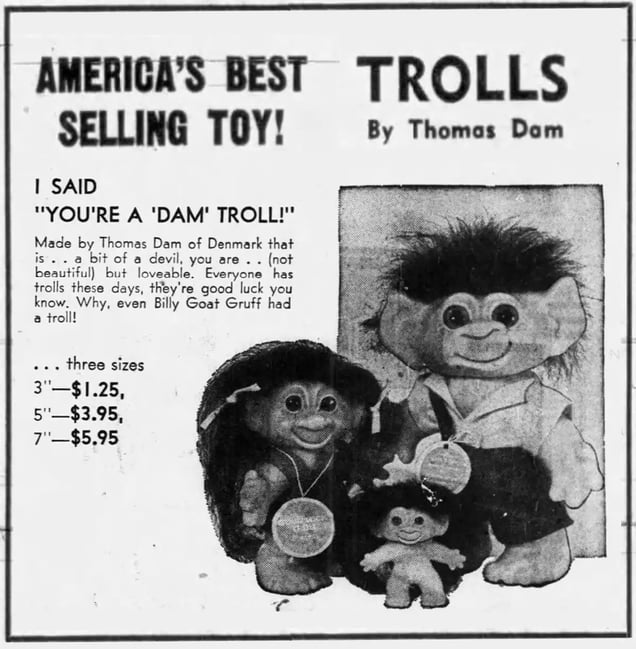
An advertisement for trolls — “America’s best selling toy” — in the Chicago Tribune in 1963 (via newspapers.com)
Dam granted a Florida company, Royalty Design, an exclusive license to manufacture his trolls in the US, eliminating the need for imports, and sales soon hit $2m per year (~$16.6m today).
By 1964, sales were booming so much that Dam Things reportedly depleted Iceland’s entire sheepskin harvest to make the trolls’ hair, causing the price of hides to go up an entire dollar.
The troll doll became a covetable good-luck charm — one that “unseated horseshoes, rabbits’ feet, and four leaf clovers.”
Stories abounded about the fortune that came from owning one:
- A prominent St. Louis lawyer claimed that his troll was responsible for tripling his business.
- A high school swim team in Florida reported winning 10 straight meets after adopting a troll as its mascot.
- Betty Miller, the first female pilot to traverse the Pacific Ocean solo, made the journey with a troll by her side for luck. Upon her return, she took the toy with her to the White House to meet President John F. Kennedy.
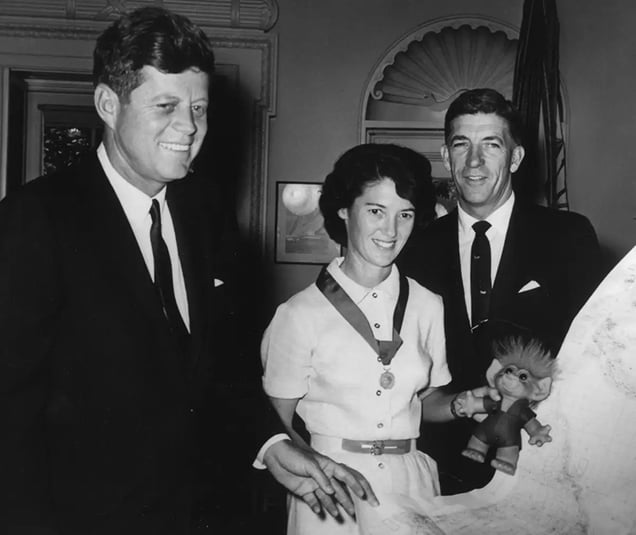
Betty Miller, the first woman to traverse the Pacific Ocean solo, with her troll doll at the White House in early 1963 (Abbie Rowe / JFK Library)
But behind the scenes, Dam Things wasn’t as lucky.
At the height of the craze, swarms of cheaply produced imitators popped up, with names like Fauni Trolls and Lucky Shnooks. Many of these copycat trolls were so similar in appearance to Dam’s design that young troll enthusiasts often didn’t even know what they were buying.
Dam’s company, still based in Denmark, had filed for a US design copyright back in 1961. And in 1965, it took action in court against a company that it claimed was infringing on its trolls without proper license.
It completely backfired.
The court found that Dam Things had failed to include a copyright mark on hundreds of thousands of trolls it sold. Furthermore, the copyright notice later molded into the left foot of the trolls — “© 1961 190918 Denmark” — was invalid, as it did not explicitly name Dam’s company.
In short, Dam and his colleagues, who were not well-versed in the intricacies of international commerce, had bungled the protection process.
Trolls, it was ruled, were in the public domain.
As a result, dozens of other counterfeit trolls popped up, almost entirely wiping out Dam’s market share. Shortly thereafter, Dam ceased production in the US and took his business back to Denmark.
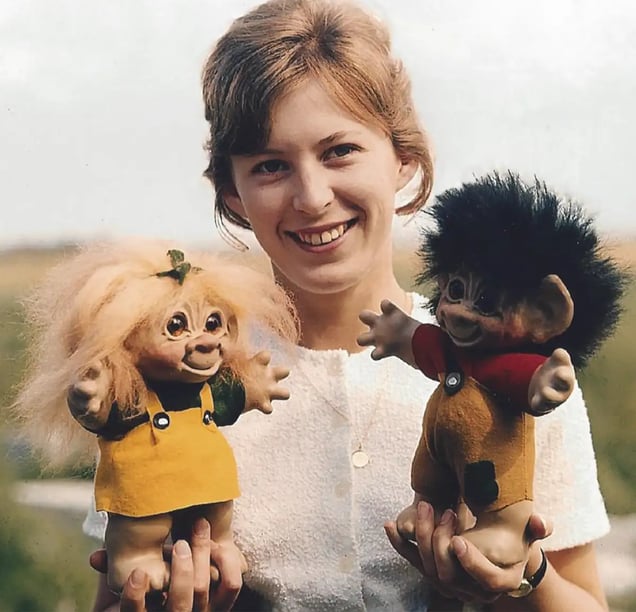
Dam’s daughter, Laja, with some of her father’s creations in the 1960s (Femina Women’s Magazine)
By the late ’60s, troll mania had tapered off almost entirely.
“Losing the copyright had a crippling impact on the business,” Dam Things’ future CEO, Calle Østergaard, said years later. “Thomas became very disillusioned and lost a lot of faith in his ability to manage a global brand. He was an artist, not a businessman.”
The troll craze, part II: 1990s
In 1982, an American entrepreneur named Steven Stark was traveling abroad and spotted a troll doll at an airport in Copenhagen.
Though the market for trolls had been dormant for more than a decade, Stark saw potential for a rebirth. So, he contacted Dam and worked out a US distribution agreement under the name Norfin.
His timing was perfect: Many of the same people who had played with trolls during the first wave now had kids of their own.
The trolls that reemerged in the early ’90s were a far cry from their modest ancestors. They came in endless varieties of hair colors, facial expressions, and outfits. A thriving merchandise industry emerged, with troll T-shirts, troll jewelry, troll games, troll stickers, and troll backpacks.
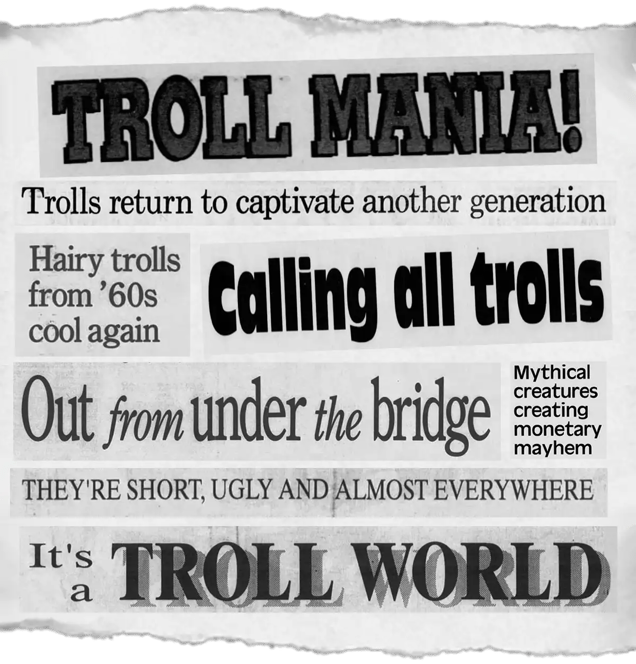
News clippings sound the troll alarm bells (various newspapers, 1992; The Hustle)
The ‘90s troll craze wasn’t limited to kids:
- There were self-proclaimed “trollaholics” who went on “troll treks” at toy stores, amassed collections of 4k+ trolls, and had business cards that read, “I be troll’n.”
- In trading groups like “Troll Monthly Magazine,” adult fans swapped trolls and debated the nuances of hair fibers.
- A retired psychiatric nurse opened a troll museum, complete with 8,130 troll dolls, in Ohio.
In 1991, troll dolls were named the Toy of the Year by the Toy Industry Association, and were the second most-promoted toy on TV after the Super Soaker.
Sales among the top three manufacturers swelled to $700m per year ($1.3B today).
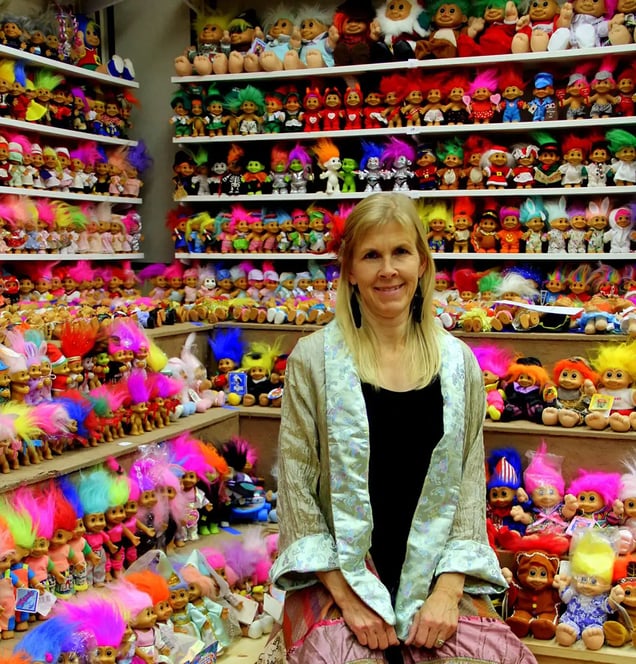
Sherry Groom poses in front of a part of her collection at the Troll Hole Museum in Alliance, Ohio (Troll Hole Museum Facebook page)
But once again, Dam’s company didn’t reap the bulk of the rewards.
Counterfeits from more than 15 companies flooded the market. Among the more prominent copycats was Russell Berrie.
During the ’60s, Berrie had sold trolls as a representative of Dam Things’ official US licensee, Royalty Design. But after Royalty went bankrupt, he began to use Dam Things’ original molds to manufacture trolls under his own “Russ Trolls” brand name. He sent numerous Dam Things products to China to be replicated and made a fortune selling them.
At the peak of the troll wave in 1992, Berrie sold $150m worth of trolls, up from $200k just four years earlier
Berrie was dubbed “King of Trolls” by the press. His wedding, which was covered by Newsweek at the time, featured a cake topped by bride and groom trolls. The party favors? More trolls.
Another firm, Ace Novelty, sold millions of Treasure Trolls with rhinestone belly buttons and inked more than 50 licensing deals.
“Let me put it this way,” an executive at the company told a newspaper at the time: “$20m would be considered excellent for the first year of a toy. Our 1992 projection is $125m domestically.”
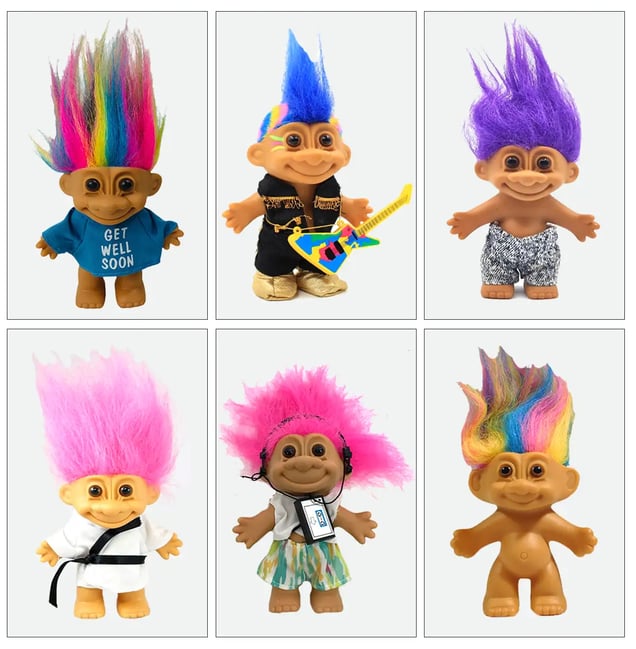
A variety of Russ Trolls from the 1990s (eBay)
Thomas Dam, the creator of troll dolls, wasn’t around to see any of this: He died from cancer in 1989, just before the second troll rush.
His successors did their best to carve out a piece of the market. But by 1994, troll sales had already sharply declined. Worse yet, a fire at Dam’s Gjøl factory destroyed priceless original molds and wiped out a large chunk of inventory.
For several years, Dam Things teetered close to bankruptcy. Then, the company finally caught a break.
The newly enacted Uruguay Round Agreements Act permitted the restoration of copyrights on foreign works that had gone into the public domain due to US compliance issues.
In 1996, after a decades-long fight, Dam Things finally had its US copyright reinstated. It proceeded to file infringement suits, forcing unlicensed trolls to withdraw from the market.
Armed with a copyright, the company then sought to make up for lost time.
The troll retires in Hollywood
Early attempts to monetize trolls in the 2000s failed miserably.
A company called DiC bought a license from Dam Things and launched Trollz — a line of “modernized” trolls in “midriff-revealing shorts and tops.” The venture was a $10m flop and contributed to DiC going out of business.
In 2012, Dam’s creation finally struck it big, inking a motion picture deal with DreamWorks.
“Trolls,” starring Justin Timberlake and Anna Kendrick, was released in 2016 and grossed $346m worldwide. Deadline placed the total value of the film’s merchandise, licensing, and ancillary troll products at $700m.
On the coattails of this success, Dam Things sold the IP of its Trolls brand to DreamWorks Animation for an undisclosed sum, retaining only the right to continue producing trolls in Denmark.
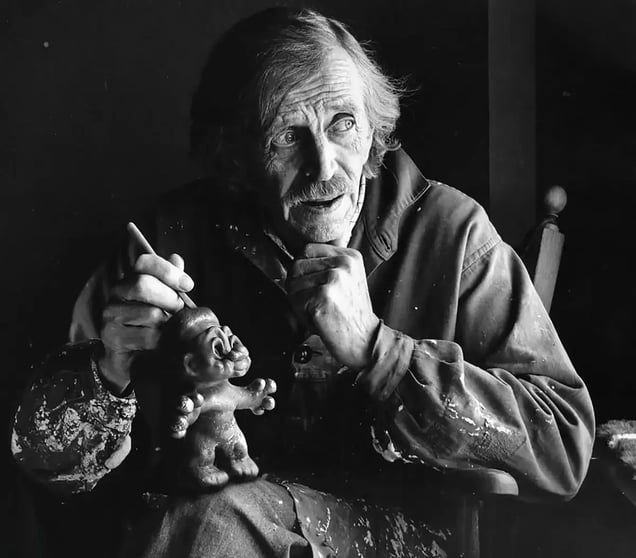
Thomas Dam in his later years (Dam family, via Classictroll.com / bySommer ApS)
For Thomas Dam’s heirs, it was a storybook ending to a tumultuous, 60-year journey.
What started as a labor of love in a Danish baker’s potato shed became a global phenomenon worth billions of dollars. It sparked toy wars, greed, and litigation.
But trolls also brought joy to millions of people around the world. And for some aficionados, that joy will transcend life itself.
“I’m going to play with my trolls forever,” a young collector with 22 trolls told a newspaper reporter in 1992. “And when I die, they’ll die. Then they’ll become troll angels and I can play with them in heaven.”

